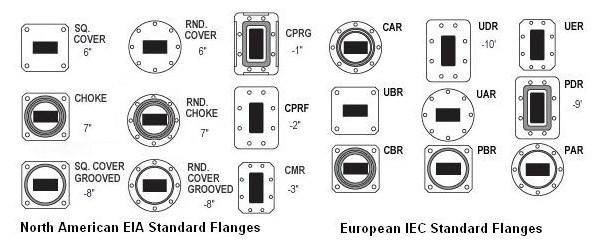|
RF |
||
|
Waveguide
As the name indicate, Waveguide is a special type of structure that can guide a wave from once place to another place. Depending on what kind of wave to be guided, there can be several different types of waveguide. If it guides RF/Microwave/mmWave, those wave guide is called 'RF/Microwave Waveguide'. If it guides optical wave, it is called Optical waveguide. If it guides sound wave, it is called 'Acoustic waveguide'.
The purpose of this page is to give you the introduction to RF/Microwave Waveguide. Followings are some examples of RF/Microwave waveguide. It is almost like a metalic pipe with rectangular or circular cross section of hollow space.
Even though you can design any shape of pipeline and cross-section shape of hollow space, there are several standardized shape at the opening at the ends of a waveguide to easily connect various kind of waveguide as shown below.
Note : This image is from http://mcli.com/documents/flanges.jpg
What determines the frequency of wave that can travel through a wave guide ?
As in most of the RF/Microwave/mmWave component (like Antenna, Coax cable), the frequency of a wave that can travel a wave guide is mainly determined by the dimension of the hollow space of the waveguide. As in Antenna, Coax Cable, the higher frequency it goes, the dimension of the hollow space (the cross section of the space) gets smaller.
Refer to Waveguide : Waveguide in practice on Wikepedia for specific waveguide type and cutoff frequency.
Why we use Waveguide ?
Main reason to use Waveguide is that it is hard to use the flexible/handy coaxial cable at very high frequency (e.g, mmWave). As the frequency goes to very high, the dimension of Coaxial cable should be very small (e.g, less than a milimeter) and just a little bit of bending of a cable would drastically influence on transfer of a wave. In terms of dimmension, Waveguide can be relatively larger than Coax cable for the same cutoff frequency. Also Waveguide does not allow arbitrary bending, so it can remove the problem caused by arbitrary bending of wave traveling path. (In some sense, this inflexibility can be a disadvantage of the waveguide, but in some sense it can be an advantage).
There is another important reason to use waveguide even in lower frequency application. Waveguide can handle much higher power (practically handling almost infinite power depending on how you design it) comparing to Coaxial cable. Due to this, you would see Waveguide is used even in such a low frequency that can be handled by Coax cable.
|
||

